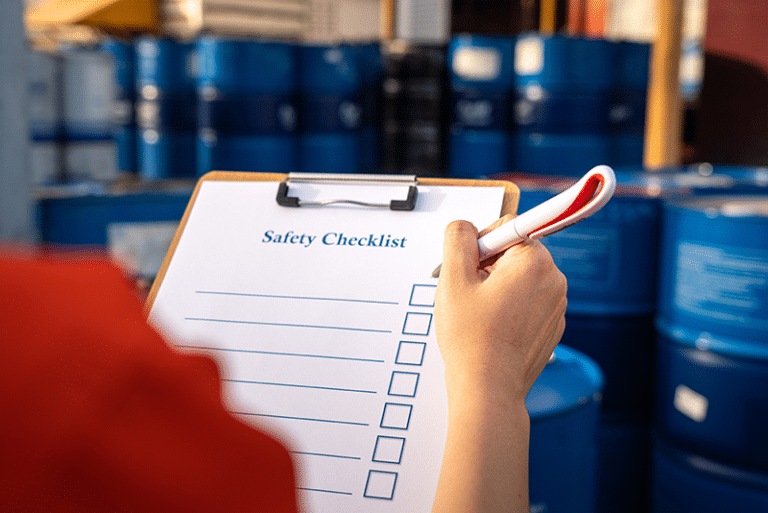A warehouse is an essential component of any business that deals with physical products. It serves as a storage space for inventory, and it is also where orders are fulfilled and shipped out.
But with the many things involved in warehouse operations, there are also a lot of risks that can pose a threat to the safety of employees, customers, and even the business itself.
That’s why it’s important to have regular risk assessments to identify potential hazards and take appropriate measures to mitigate them.
What Is a Warehouse Risk Assessment?
A warehouse risk assessment is a process of identifying potential hazards in your warehouse operations and evaluating their likelihood of occurring and their potential impact on people and the business.
It also involves inspecting your facility, equipment, processes, and procedures to identify areas where improvements are needed.
The goal of a risk assessment is not only to ensure compliance with regulations but also to create a safer work environment for employees and customers while protecting the business from costly accidents or lawsuits.
What are the Most Common Risks in a Warehouse?
Warehouses can be dangerous places if proper safety protocols are not followed. Here are some of the most common risks in a warehouse:
- Slips, Trips, and Falls: These are some of the most common accidents in any workplace, not just warehouses. They can be caused by uneven surfaces, wet floors, poor lighting, or obstacles in walkways.
- Falling Objects: In a warehouse, goods are often stored at height. If not secured properly, these objects can fall and injure people.
- Forklift Accidents: Forklifts are commonly used in warehouses to move heavy goods. If not operated correctly, they can lead to accidents. This could include overturning, collisions, or dropping loads.
- Manual Handling Injuries: These occur when people lift, carry, push, or pull objects improperly. This can lead to musculoskeletal injuries, including strains and sprains.
- Fire Hazards: Flammable materials, faulty electrical equipment, or poor housekeeping can increase the risk of fires in warehouses.
- Hazardous Materials: Warehouses often store chemicals or other hazardous substances. If these are not stored or handled correctly, they can cause serious harm.
- Lack of Proper Training: Workers who are not properly trained in safety procedures are at a higher risk for all kinds of accidents.
- Noise Exposure: Chronic exposure to high levels of noise can lead to long-term hearing damage.
- Inadequate Safety Equipment: Lack of personal protective equipment (PPE) can expose workers to various safety risks.
- Prolonged Standing or Repetitive Tasks: These can lead to various health issues, including chronic pain, repetitive strain injuries, and circulatory problems.
To reduce these risks, it’s important for warehouse operators to have comprehensive safety policies in place and to ensure that all employees are well trained on these policies. Regular safety audits can also be beneficial to identify and rectify potential hazards before they cause harm.
The Importance of Conducting a Warehouse Risk Assessment
Conducting regular risk assessments can help you with the following:
- Identify potential hazards before they lead to accidents or injuries
- Protect your employees from harm
- Comply with regulations
- Reduce insurance premiums
- Avoid costly lawsuits
- Improve operational efficiency
How Often Should You Conduct a Warehouse Risk Assessment?
The frequency of conducting a warehouse risk assessment will depend on several factors such as:
Changes in Operations
If there have been significant changes in your warehouse operations such as new equipment or processes introduced or changes in product lines or volumes handled, then it may be necessary to conduct an immediate risk assessment.
Regulatory Requirements
The specific requirements will depend on where your warehouse is located.
You can also check some general information from the Occupational Safety and Health Administration (OSHA) regarding standards and enforcement initiatives relevant to warehousing and storage. It also provides national standards and recommendations from professional organizations.
Incident History
If there have been any accidents or incidents within your warehouse, it’s essential to conduct an immediate risk assessment to identify the root causes and prevent similar incidents from occurring in the future.
Timeframe
It’s recommended that you conduct a full warehouse risk assessment at least once every two years. This can vary depending on the size of your facility, complexity of operations or if there are any significant changes in your operations.
Risk Exposure
If your business handles hazardous materials or operates heavy machinery, then more frequent assessments may be necessary to ensure safety compliance.
What to Include in a Warehouse Risk Assessment?
A comprehensive warehouse risk assessment should include the following measures:
Hazard Identification
This involves identifying potential hazards within your operations such as slips and falls, fires, electrical hazards or exposure to harmful chemicals.
Identifying hazards is a vital component of any effective workplace safety and health management system. It serves as the first line of defense against potential harm to workers and is essential in maintaining a healthy and safe environment.
What is Hazard Identification?
Hazard identification is the process of detecting potential sources of harm in a work environment. These sources, also known as hazards, could lead to physical injury, mental health problems, disease, or damage to equipment or the environment.
Hazard identification is not a one-time process. Rather, it’s an ongoing activity that requires regular monitoring and reviewing, as work environments can change, new equipment may be introduced, and different tasks might be undertaken.
How to Conduct Hazard Identification
The following steps will guide you in creating an effective hazard identification process:
1. Walkthrough Inspections: Regular inspections of the work environment can help identify new or overlooked hazards. During a walkthrough, look for anything that could potentially cause harm. This could range from loose wires, unstable shelving, improperly stored chemicals, or anything else that seems out of place or dangerous.
2. Job Hazard Analysis: This involves reviewing each task performed by employees to identify any hazards associated with them. It’s crucial to understand the process involved, equipment used, and potential risks that may emerge during each task.
3. Employee Consultation: Workers often have first-hand knowledge of the hazards in their work environment. Engaging them in the hazard identification process can be extremely valuable. This can be done through surveys, meetings, or suggestion boxes.
4. Incident and Accident Reports: Past incidents can provide valuable information about the hazards in a workplace. By reviewing accident and incident reports, you can identify trends and address recurring hazards.
5. Manufacturer’s Data: Equipment and chemical manufacturers provide safety data sheets (SDS) and manuals that outline potential hazards and safety measures. These can be a great resource in the hazard identification process.
Benefits of Hazard Identification
Hazard identification serves as a preventative measure. By identifying hazards early, appropriate control measures can be implemented to reduce or eliminate the potential for harm.
It also fosters a safety culture within the organization. When employees are involved in hazard identification, they become more aware of their surroundings and the importance of safety, enhancing overall safety performance.
Additionally, a well-executed hazard identification process can aid in legal compliance, reduce workplace injuries, and therefore decrease the costs associated with accidents and illnesses, such as workers’ compensation and lost productivity.
Hazard identification is a vital practice in ensuring workplace safety. It requires a proactive approach, constant vigilance, and the active participation of everyone in the organization. By identifying and controlling hazards, businesses can create a safer, healthier workplace and protect their most valuable asset – their employees.
Risk Assessment
Once you have identified potential hazards, you need to evaluate their likelihood of occurring and their potential impact on people and the business.
Risk assessment is a crucial element in maintaining a safe and healthy work environment. It’s a systematic process that involves identifying hazards, evaluating the risks associated with those hazards, and determining suitable ways to eliminate or control the hazards.
Understanding Risk Assessment
Risk assessment refers to the overall process or method where you:
- Identify hazards and risk factors that have the potential to cause harm (hazard identification).
- Analyze and evaluate the risk associated with that hazard (risk analysis, and risk evaluation).
- Determine appropriate ways to eliminate the hazard or control the risk when the hazard cannot be eliminated (risk control).
A risk assessment is not a one-off activity. It should be an ongoing process, continuously reviewed and updated to reflect any changes in the work environment, processes, or personnel.
Steps to Conducting a Risk Assessment
1. Identify the Hazards: The first step in a risk assessment involves recognizing the potential sources of harm in the workplace. This can be done through methods like workplace inspection, job safety analysis, employee feedback, reviewing accident and near-miss records, and consulting material safety data sheets (MSDS).
2. Determine Who Might Be Harmed and How: Once hazards have been identified, it’s necessary to understand who might be at risk and how they might be harmed. This step should consider all individuals who have access to the workplace, including employees, contractors, visitors, and the public.
3. Evaluate the Risks and Decide on Precautions: This involves evaluating the likelihood and severity of the harm that could result from each hazard, and then deciding on the best course of action to either eliminate the risk or control it. This may include implementing safety procedures, providing personal protective equipment, or changing work practices.
4. Document Your Findings and Implement Them: Once the risks have been evaluated and precautions determined, it’s important to document these findings. This record keeping is crucial for both legal compliance and as a reference for future risk assessments.
5. Review Your Assessment and Update if Necessary: The risk assessment process should be dynamic and not static. It should be reviewed regularly and especially when significant changes occur in the workplace, such as the introduction of new equipment, substances, or procedures.
The Importance of Risk Assessment
Performing risk assessments not only helps to promote a safer and healthier workplace, it also enables an organization to comply with legal obligations to protect their employees. Risk assessments provide a structured way of looking at potential threats in a workplace and making decisions about how best to control them.
Through conducting risk assessments, organizations can reduce incidents and accidents, thereby minimizing potential financial costs such as medical expenses, compensation claims, and lost productivity. Importantly, regular risk assessments can contribute to a strong safety culture within the organization, where employees and management work together towards a safer working environment.
Control Measures
After evaluating potential risks, develop control measures that will help prevent or minimize those risks such as providing safety equipment for employees or implementing safety procedures for handling hazardous materials.
Implementation Plan
Develop an implementation plan outlining how you will implement control measures and assigning accountability for each task.
Review and Monitoring Plan
Set up a review process to monitor progress against implementation plan milestones and adjust plans accordingly if necessary.
Designing a Workplace Risk Assessment Checklist
When creating a workplace risk assessment checklist, several factors contribute to the effectiveness of the safety audit.
- Make sure to clearly define key terms such as risk, accident, hazard, and any other relevant terms used in the checklist. This will help prevent confusion during or after the warehouse risk assessment.
- Take into account both the interior and exterior sections of the warehouse. A comprehensive risk assessment checklist should evaluate areas both inside and outside the warehouse, ensuring that your workers can feel secure while on the job.
Foresee the Troubles Ahead
Ensuring effective management is crucial for the safety of your products and resources, allowing for seamless warehousing operations. If your warehouse encounters a setback due to an accident or hazard, it could force a pause in your entire supply chain.
As the saying goes, prevention is better than cure. So, it’s essential to take every necessary precaution to guarantee the safety and efficiency of your warehouse. At Canal Cartage we work hard to maintain a safe, risk-free warehousing environment for our customers and employees. If you are interested in warehousing opportunities, please contact us today for a free assessment on working with our company.



